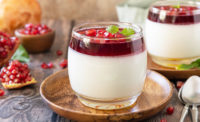The future for dairy and plant-based hybrids
By incorporating plant-based proteins into dairy products, manufacturers could tap into trends, appeal to new markets and add functional characteristics.

Consumer interest in sustainable agriculture and food production systems is growing worldwide, and the related demand for plant-based alternatives to milk-based yogurts and cheeses has been increasing in recent years. The global market for plant-based dairy alternatives is currently growing at a compound annual growth rate of 13.3%, with a projected market value of $53.9 billion in the year 2028.
Challenges with plant-based dairy alternatives
Many plant-based dairy-like products claim to offer the same nutritional and functional benefits and consumer experience as their dairy-based counterparts. However, proteins present in milk (i.e., caseins and whey) offer unique texture, mouthfeel, and sensory characteristics due to their inherent structure and functional properties; plant proteins lack these attributes.
The micellar form of casein imparts unique acid- and rennet-gelling characteristics to milk, which is not achievable from globular plant proteins. Further, milk is extremely nutrient-dense, with high-quality protein and minerals, compared to many plant-based proteins. Similarly, from a food processing and formulation perspective, dairy proteins are highly functional because they can be used in applications with diverse food matrices.
On the other hand, many plant proteins are hydrophobic in nature; therefore, they require in-depth processing to be incorporated in end-user applications.
Hybrid phenomenon
The most common ingredients used to manufacture dairy-alternative products are nuts, seeds, and grains. Nuts used to make these products include coconut, peanut, and hazelnut; seeds include soy, flax, and hemp; and grains include oats and rice.
However, it is almost impossible to mimic some of the functional properties of dairy just by using these plant-based proteins. The net result of these factors is the growth of the hybrid phenomenon: foods containing both dairy and plant-based proteins. Hybrid products can achieve desirable functionality, as well as adequate and cost-effective nutrition.
Adding plant-based ingredients to traditional dairy foods comes with additional challenges such as modification of textural and sensory attributes. To make hybrid products acceptable to consumers, it is important to match the sensory characteristics of these newly developed products to the standard consumers expect.

Niche market potential
There is an increase in the consumption of dairy products in some geographic regions, including China and other East Asian countries where dairy products have not traditionally been part of the traditional consumption pattern. Consumers in these countries are becoming more aware of the convenience, nutrition, and functionality offered by dairy.
Traditional Asian diets were mainly composed of plant-based food products. Therefore, the addition of plant-based ingredients to dairy products such as cheese and yogurt could increase the acceptance of dairy foods in these countries. Incorporating plant-based ingredients may offer a means to achieve sensory characteristics more appealing to Asian consumers.
Potential to create unique structures
Combining plant-based materials with dairy-based matrices could open avenues for creating new products with unique sensory properties. An example of such an innovation is the incorporation of polysaccharides in cheese matrices to increase the moisture content, which could modify its functional properties such as adhesiveness, meltability, and flavor release. The addition of plant proteins such as soy and pea could also result in cheeses with a softer texture. Co-gelation of soy or pea protein with casein may result in a gel structure consisting of two independent protein gels with unique functional characteristics.
Looking for a reprint of this article?
From high-res PDFs to custom plaques, order your copy today!






